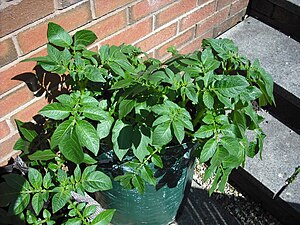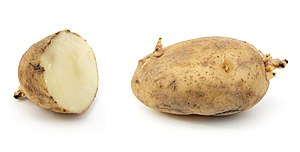However, there is nothing to stop you growing winter potatoes in a conservatory or greenhouse, for example, even if you live in a place where frost and snow are common in winter. You will simply need a greenhouse heater that switches on automatically to prevent the temperature dipping below the freezing point.
| Potatoes growing in container. (Photo credit: Wikipedia) |
What is chitting and is it necessary?
You will often see recommendations that you should leave potatoes in a dark, cool place and wait for them to begin to sprout (chitting) before you plant them. If you have time to do this, that's great. You may see that some potatoes are failing to sprout and you can pick out the ones with the healthiest looking sprouts to plant. However, if you don't have time for this, don't worry about it. Most potatoes will grow just fine without chitting.
If using tub containers, you can put 3 plants into an 18 inch diameter container. Be sure that the containers are cleaned well with water and have drainage holes. Place a couple of inches of gravel at the bottom of the container to prevent waterlogging.
Then, for growing winter potatoes, place 3 inches of mulch, leaves or straw on top of the gravel. This will produce heat as it breaks down and help to keep the potatoes frost free.
| 1 and a half russet potato with sprouts.(Photo credit: Wikipedia) |
The plants will continue to grow after the container is full. Then they will flower and a few weeks later the tops will start to die off. At that time the potatoes are ready. If you leave them a couple more weeks, they will continue to grow bigger.
Good varieties are Maris Peer, Charlotte and many others. You can buy seed potatoes or (provided you are growing in containers) you can use organic potatoes from the grocery store or locally grown organic potatoes from a farmers' market.
Do not plant bought potatoes that are not seed potatoes in the soil of your garden, however, because they can carry disease which will then stay in the soil and affect future crops. For the same reason, if you grow grocery store potatoes in containers, do not spread the compost on your garden after you are done growing winter potatoes.



No comments:
Post a Comment